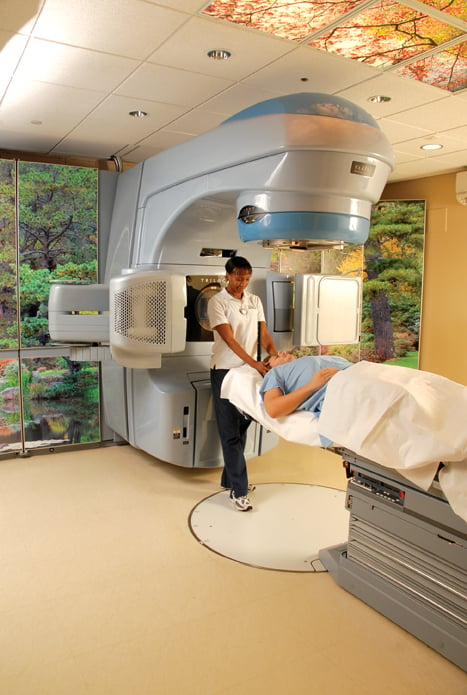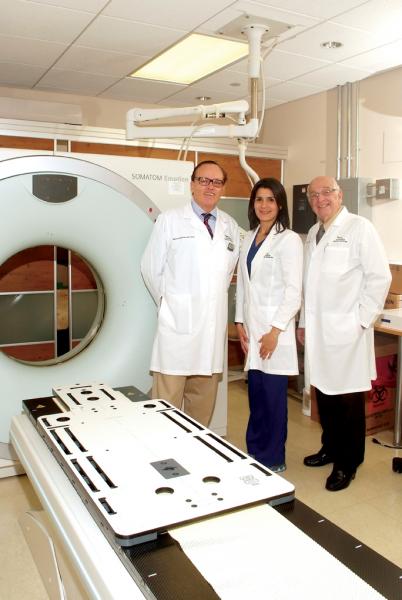
ICI delivers radiation therapy using a linear accelerator.
Beatriz Amendola, M.D., FACR, FASTRO, radiation oncologist, medical director, Innovative Cancer Institute (ICI), decided to work in solo practice in 1999 after moving from Philadelphia to Miami. In Miami, she found there were no privately owned, freestanding facilities offering radiology oncology services to patients. All services were either rendered through a hospital or through a university. That is when Amendola decided to start her own practice, founding the Brachytherapy Center of South Florida in 2002, which is mostly dedicated to the management of early breast cancer and skin cancer using brachytherapy.
As her practice continued to grow, she decided to open a center where she would offer not only the latest technology, but also where patients could have one-on-one personalized care. In July 2008, Amendola along with her husband Marco Amendola, M.D., FACR, FSUR, a diagnostic radiologist with a strong background in radiation oncology, and her consultant, medical physicist Xiaodong Wu, Ph.D., opened ICI. Today, ICI has 16 employees and sees on average 30 to 40 patients a day.
Advanced Technological Offerings
Varian Medical Systems’ RapidArc radiotherapy technology has given physicians at ICI the ability to perform a multitude of progressive treatments. ICI was among the first in the Southeast region to invest in the technology after the U.S. Food and Drug Administration (FDA) approved it in January 2008. RapidArc technology delivers image-guided, intensity-modulated radiation therapy (IMRT) faster and more precisely than conventional IMRT. According to Varian, the technology varies the rotation speed of the treatment machine, the rate of dose delivery and the dimensions of the beam-shaping aperture — all simultaneously — to “create a finely-shaped IMRT dose distribution that closely matches the size and shape of the tumor.”1 The technology is also known to reduce secondary radiation by more than 50 percent when compared to conventional IMRT.[1]
ICI uses RapidArc with on-board imaging for stereotactic radio surgery (SRS) — a procedure that delivers high doses of radiation to tumors in the brain and the spinal column via precise radiation beams. The center was a pioneer of SRS in the Southeast. Amendola’s extensive background in SRS made its introduction and implementation at the center a natural process. Her research in the field dates back to the early ‘90s, when she began observing and then working at Miami’s first Gamma Knife center in Coral Gables, Fla. In 2003, she began working with the first Accuray CyberKnife robotic radiosurgery system in Miami. “All of this experience helped us to create our radiosurgery program at the Innovative Institute,” Amendola said. ICI’s program utilizes SRS for the treatment of cranial and extracranial tumors. The center also uses RapidArc to plan and guide stereotactic body radiation therapy (SBRT).
Treatment Options
Utilizing the latest technology has allowed ICI to offer its patients a variety of treatment options based on their specific needs. For example, of patients who present with early-stage breast tumors where cosmesis and breast preservation is so important, Amendola said, “We give them the choice: Do you want to have partial-breast irradiation or whole-breast radiation? We can do brachytherapy, and we also are trained and experienced in balloon brachytherapy methods. We own a VariSource brachytherapy system from Varian; we can offer 10 fractions of radiation in five days with very low recurrence rate.” Amendola has utilized these techniques since 2002, and has had less than 2 percent local failure in the more than 400 patients treated to date. For those breast cancer patients who present with large breasts, the center has immobilization devices and techniques that introduce a lot less toxicity to the skin, sparing the lungs and the heart, and treating patients in prone position if necessary. In this manner the normal tissues, heart, lungs and skin receive less radiation.
Improved Efficiency and Patient Outcomes
For Amendola, less toxicity and more accurate delineation are the key patient outcomes of target-guided therapy. “With image guiding you can trust that you can go to smaller field sizes and you can deliver higher doses, hence you will have a better local control. We have patients with large tumors where we have increased local control with a lot less toxicity,” she said. “Our patients with prostate cancer rarely get any side effects, and we use high curative doses of radiation. Other facilities that lack the technology and the image guidance may need to curtail the total dose given to avoid toxicities.”
The speed of advanced technology has also provided patients with added comfort during treatment. “These treatments are not only precise, but they are rapid,” she said. This is important for those patients who have back pain or other sources of discomfort, and cannot stay still for a long time on the treatment table. According to Amendola, RapidArc delivers treatment in less than two minutes compared to 25 to 30 minutes for conventional IMRT. Amendola said most of the radiosurgeries performed at the center do not exceed 10 minutes. “If we use one arc we can deliver a treatment, on time, in less than two minutes. If we do two arcs to get more precise delivery, we can treat in less than four minutes.”
This gives satisfaction not only to patients, but also to the technologists who rarely get behind in their daily schedules. “They never get behind because they can make up the time. The planning is also faster and is more precise,” Amendola said. “Also, the dosimetrists can do their plans faster and they feel more comfortable.”
Reducing Patient and Insurance Costs
Another benefit of utilizing advanced technologies has been the reduced cost to patients and insurance companies. ICI’s use of hypofractionated techniques, including SBRT, has been a great source of cost savings. Unlike standard radiation, which provides patients with frequent sessions of low-dose radiation treatments, in hypofractionation, the patient receives larger doses of radiation per fraction, less frequently. “Other centers, to reduce toxicity, have to sometimes extend the treatment to four weeks for metastases. We can do three fractions or five fractions using hypofractionated techniques, and that is less costly for the insurance carriers,” Amendola said. She pointed out that this can only be achieved using on-board imaging and related advanced technologies.
The techniques employed in ICI’s radiation therapy treatments have also offered cost benefits in the long run. “Radiation therapy is a very important component in the management of cancer,” she said. “As this technology is getting better and we know how to use it better and more safely, we can improve cure rates. With these technologies, the patients are going to have less recurrences.” She explained that the high doses of localized treatment that patients receive from IMRT, SBRT and SRS result in fewer recurrences, and the patient can be cured. “With lower doses of delivery, the tumor may recur and then the costs of treatment are much higher,” she explained. “The first time you treat the patient is the best chance you have to cure the patient.”
Treating Ocular Melanoma
Not only has ICI been able to help patients using standard technologies, but it also has been able to branch off and treat unusual cancers. This includes the ICI’s ocular melanoma program, which stems from Amendola and Wu’s long interest and experience with ocular melanoma and other eye tumors at the former Hahnemann University at Wills Eye Hospital in Philadelphia. Amendola, along with a noted ophthalmologic surgeon, her physicist Wu and Omar Salazar, M.D., FACR, FACRO, a well-known radiation oncologist with vast experience in radiosurgery and lung cancer who joined ICI June 2012, started the program in their local hospital in December 2012. “This is an inpatient program. The patients are seen in our office, where we do the planning and they are treated by our team in the OR,” she said.
Personalizing Patient Care
Amendola said that the most important aspect about offering advanced treatment is the ability to give patients the best treatment available. “Ultimately the patient is the most important thing,” she said.
For Amendola, patient care does not end with these technologies, but rather extends past it. Although there are times that patients need services that she cannot provide, patient care does not stop. “When the patient comes in and I know they need a surgeon or they need a medical oncologist, I have a large group of physicians that we feel comfortable trusting with the care of our patients. They are very much similar in the way we treat patients,” she said. Amendola can then refer patients for a consult with a neurosurgeon or a gynecological oncologist, and know that patients are getting the same standard of care offered at ICI. “We try to offer the patient the best specialist for the particular need. We go according to insurance, and if they don’t have insurance, we know what facility we can send them to get the best rates.”
Even when treatment options fail, Amendola insists that patient care continues. “If you cannot offer the patient treatment, you must be able to guide the patient to palliative care or hospice. You need to be there for the patient and the family in their time of need.”
Reference:
1 Varian RapidArc Delivers Volumetric Modulated Arc Therapy http://www.itnonline.com/tech/varian-rapidarc-delivers-volumetric-modul…, accessed Aug. 1, 2013




 December 11, 2025
December 11, 2025 









